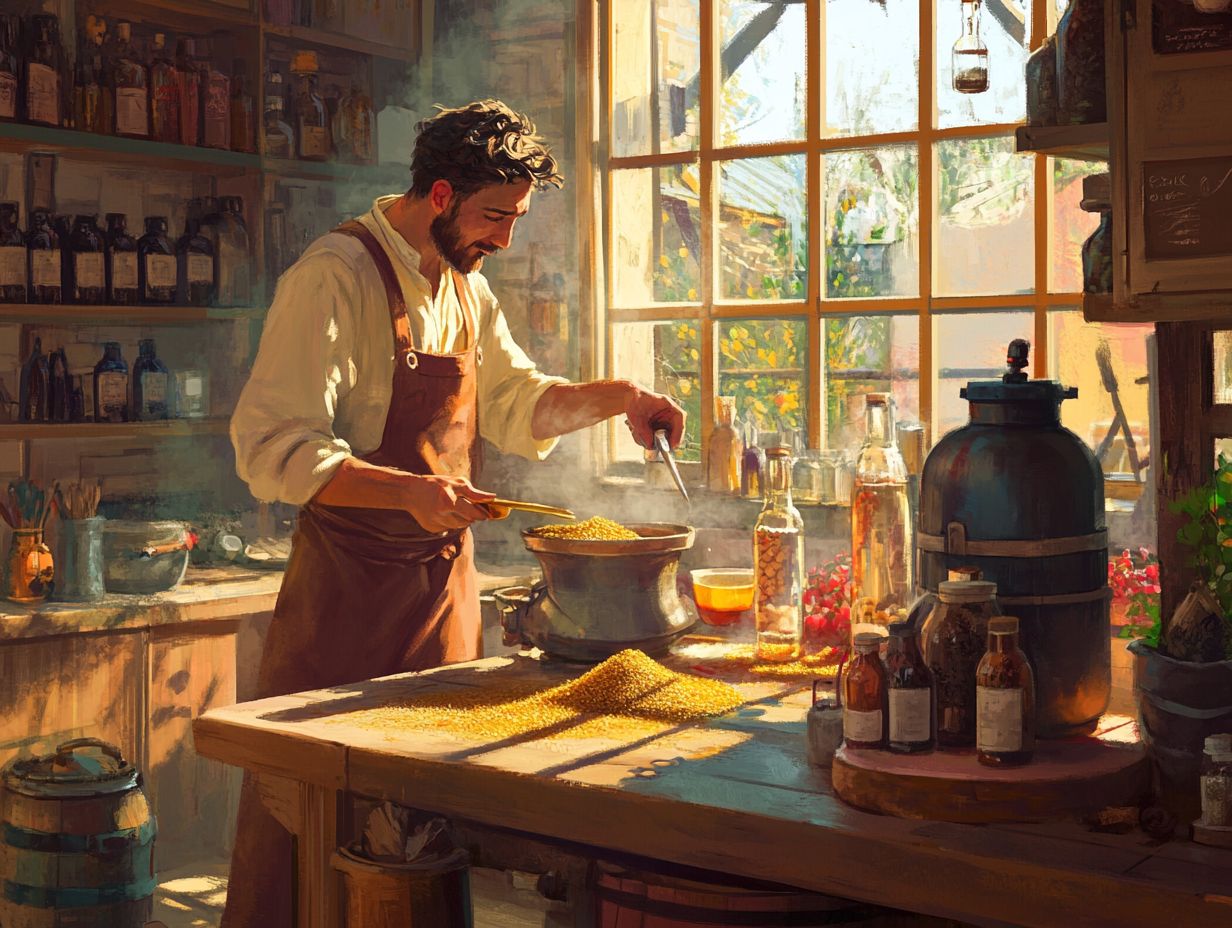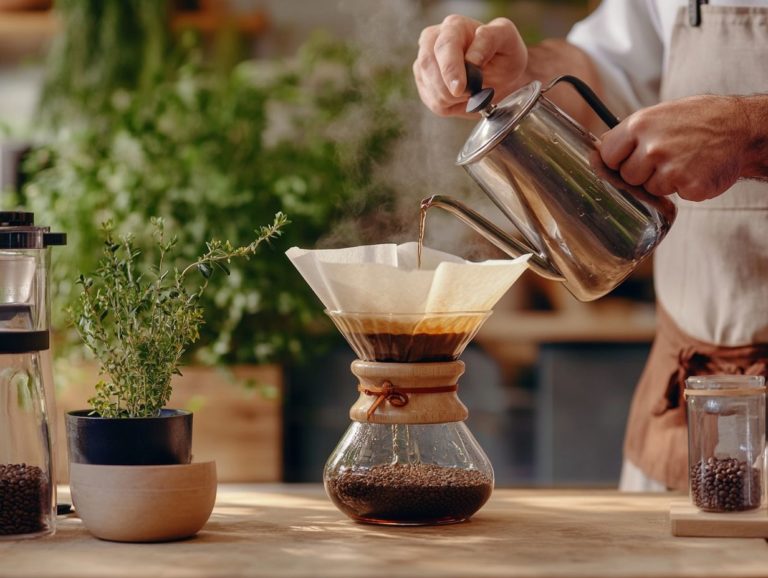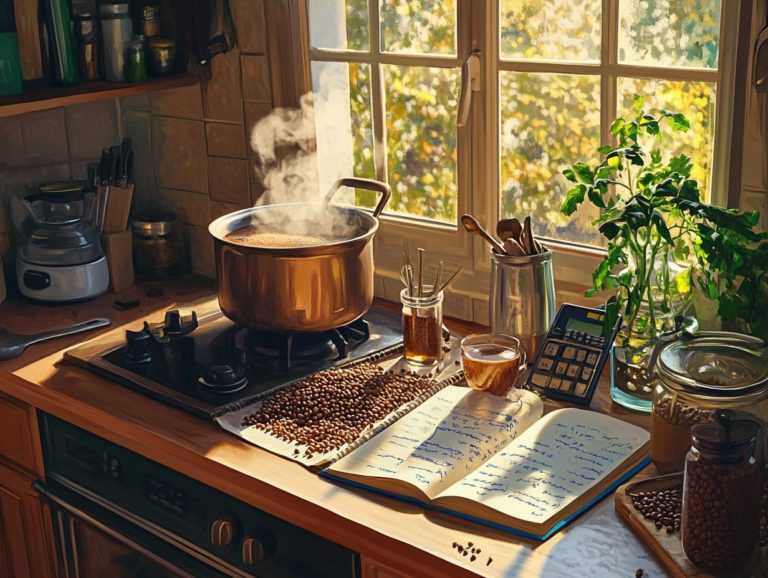Exploring Non-Traditional Brewing Techniques
In the ever-evolving world of brewing, non-traditional techniques and unique ingredients are capturing the attention of both enthusiasts and seasoned brewers alike. These innovative methods inspire a spirit of experimentation, unlocking unique flavors and aromas that challenge conventional brewing norms.
Whether you find yourself intrigued by sour brewing or curious about barrel aging, this guide delves into the diverse landscape of innovative brewing practices and modern craft beer.
You ll learn how to seamlessly incorporate these exciting techniques into your own brewing process while skillfully navigating any potential challenges that may arise, such as allergen concerns or legal restrictions. Get ready to elevate your brewing game to new heights!
Contents
- Key Takeaways:
- Why Explore Non-Traditional Brewing Techniques?
- Types of Non-Traditional Brewing Techniques and Brewing Methods
- 3. Wild Fermentation Techniques
- 4. Kveik Brewing Techniques
- 5. Nitro Brewing
- How to Incorporate Non-Traditional Techniques into Your Brewing Process
- Frequently Asked Questions
- What are non-traditional brewing techniques?
- Why would someone want to explore non-traditional brewing techniques?
- Are there any risks associated with non-traditional brewing techniques?
- What are some examples of non-traditional brewing techniques?
- Do non-traditional brewing techniques require special equipment?
- Can homebrewers explore non-traditional brewing techniques?
Key Takeaways:
Why Explore Non-Traditional Brewing Techniques?
Exploring non-traditional brewing techniques is crucial for you, whether you’re an aspiring brewer or an established craft brewery owner. This approach not only sparks creativity and innovation but also aligns with the ever-changing consumer preferences of today s discerning craft beer consumers.
By integrating unique ingredients like barley, rye, and oats, you can craft seasonal flavors that truly resonate with beer enthusiasts, broadening the flavor spectrum of your offerings. Embracing techniques such as wild fermentation and the inclusion of herbs and spices unlocks exciting possibilities for flavor experimentation, ensuring that you stay competitive and relevant in a market that thrives on diversity and quality. This approach also pays homage to the cultural significance and historical examples of beer brewing traditions.
1. Experimentation and Creativity in Brewing Techniques
At the heart of craft brewing lies experimentation and creativity, empowering you to push the boundaries of traditional brewing methods and craft unique flavor profiles that truly stand out in a crowded market.
This innovative spirit invites you to explore unconventional ingredients, seamlessly integrating herbs, spices, and alternative grains into your creations. For example, you might consider incorporating chamomile or lavender to offer floral notes that beautifully complement hoppy undertones. Others have ventured into the realm of ancient grains like quinoa or spelt, resulting in beers that boast distinct textures and flavors. This also involves meticulous recipe development and balancing flavors to achieve the desired taste.
These daring choices not only cater to adventurous palates but also capture attention in a competitive landscape, subtly shifting consumer preferences towards more diverse and flavorful options. This trend represents a significant evolution in the craft beer scene, as drinkers increasingly seek out unique brews that tell a story and challenge their expectations. Additionally, local producers play a crucial role in this evolution, fostering a deeper connection between the beer and its place of origin.
2. Unique Flavors and Aromas in Craft Brewing
Incorporating unique flavors and aromas in brewing not only excites your palate but also showcases the rich diversity of ingredients and techniques that define the craft brewing process.
By embracing seasonal flavors, wild yeast strains, and an array of herbs and spices, you can create innovative beers that resonate with those seeking new taste experiences. Imagine a craft brewery known for its adventurous spirit utilizing fresh cherries and locally sourced spices to craft a summer wheat ale with a tart and refreshing profile. Alternatively, consider another brewery experimenting with wild yeast fermentation, resulting in a complex interplay of fruity aromas and funky notes that culminate in a distinctive sour beer, captivating enthusiasts. Such creative endeavors highlight the importance of flavor extraction and taste modulation in brewing processes.
These inventive approaches not only cater to evolving taste preferences but also invite you to explore and savor the nuances of seasonal and artisanal ingredients. Emphasizing flavor diversity, these methods bring new dimensions to the craft beer experience.
3. Cost-Effective Brewing Techniques
Adopting non-traditional brewing techniques is a smart, cost-effective strategy for craft breweries. This approach helps you stand out in a crowded market without breaking the bank.
By incorporating locally sourced and budget-friendly ingredients, you can craft unique flavors that resonate with your community while keeping production costs in check. It’s essential to address allergen concerns, especially as more consumers seek gluten-free options.
Many breweries have successfully navigated this terrain by exploring alternative grains like millet or buckwheat. These can produce excellent gluten-free beers without compromising on taste.
Consider the example of a microbrewery that embraced these innovative practices. They enriched their menu with bold, inclusive offerings that cater to a wider audience while being fiscally responsible.
Such creative approaches not only support local agriculture but also nurture a loyal customer base that values thoughtful brewing. As industry trends shift, these microbreweries stay ahead by continually innovating their brewing practices.
Types of Non-Traditional Brewing Techniques and Brewing Methods
You ll find an array of non-traditional brewing techniques that craft breweries are embracing to produce innovative and flavorful beers. Each method brings its own unique characteristics and processes, allowing for an exciting exploration of flavors and styles.
1. Sour Brewing Techniques
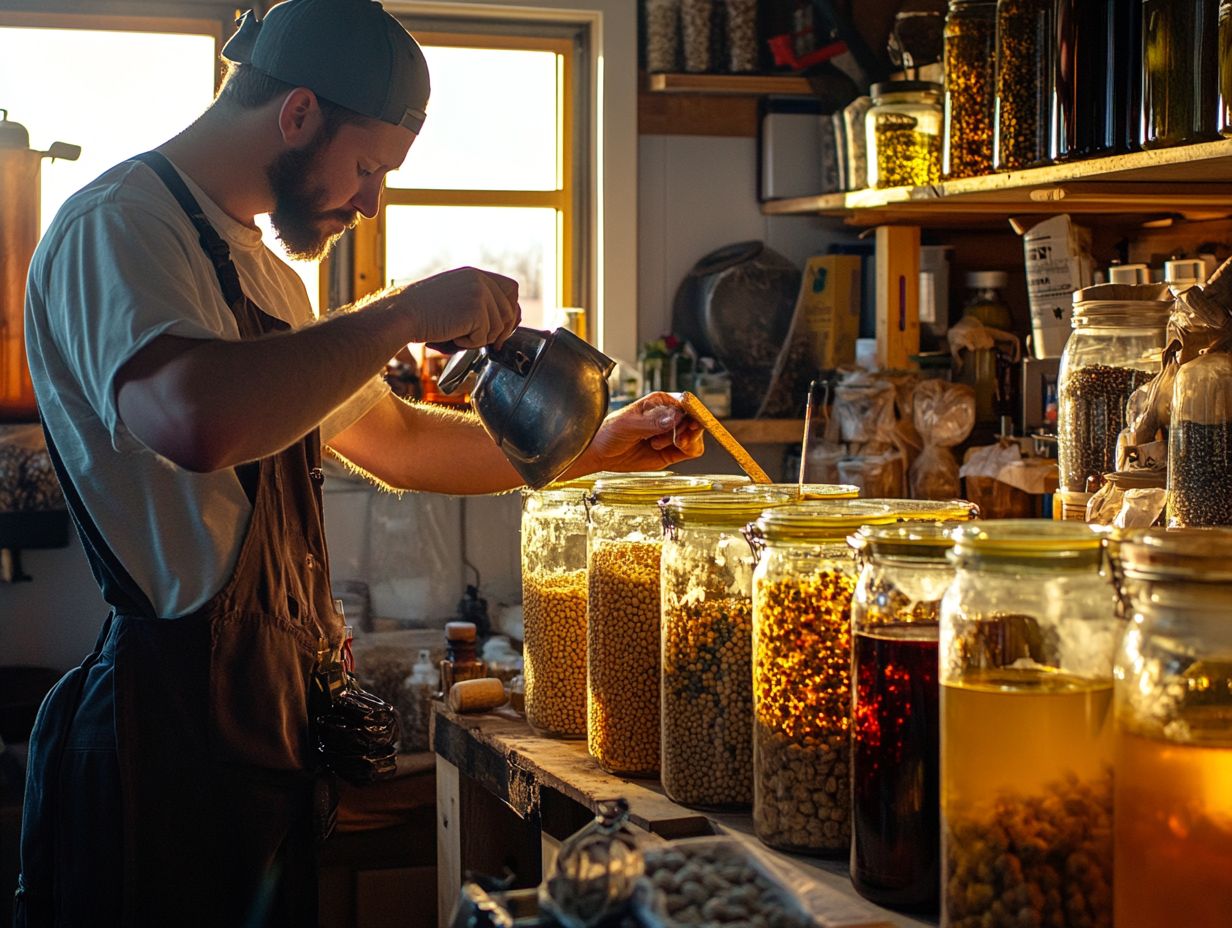
Sour brewing harnesses the power of microbes like Lactobacillus and Pediococcus, inviting brewers to create craft beers with a tart and refreshing flavor profile. This method appeals to a niche yet expanding audience.
This unique brewing technique demands careful control of fermentation. You will need to manage temperature and timing to encourage the right bacterial activity, resulting in a delightful array of complex flavors.
The variations in souring techniques, such as kettle souring or wild fermentation, yield diverse outcomes. Kettle souring typically offers a quick turnaround time, imparting a clean, crisp tartness to your beer. In contrast, wild fermentation introduces unpredictable nuances that can take months or even years to develop.
Notable breweries like The Bruery and Cascade Brewing have garnered attention for their innovative sour ales. They capture the hearts of adventurous consumers eager to dive into this tangy style.
Fans of sour beers often rave about their vibrant profiles and surprising depth. This reflects a growing appreciation for these unconventional brews amidst traditional lagers and ales. These breweries exemplify the balance of innovation and tradition in their brewing methods.
2. Barrel-Aged Brewing Techniques
Barrel-aged brewing has become a fascinating trend among craft breweries. It enables you to explore complex and rich flavors by aging your beers in various barrels.
This method brings unique characteristics from the wood itself and adds subtle nuances from whatever was previously stored inside think bourbon, wine, or rum thereby enhancing the overall taste profile. Barrel-aged brews are particularly noted for their depth and layered flavors.
The beauty of this process lies in its ability to craft innovative flavors. It showcases your skill as a brewer in the art of flavor experimentation. For instance, brews aged in whiskey barrels carry delightful notes of caramel and vanilla, while those aged in wine barrels could surprise you with fruity undertones and enhanced sweetness perception.
The success of barrel aging heavily relies on meticulous quality control at every stage. From handpicking the right barrels to carefully monitoring temperature and aging time, you ensure that each batch achieves the desired flavor complexity.
This attention to detail is what sets exceptional barrel-aged beers apart in the ever-evolving landscape of craft brewing. Don’t miss out on the chance to explore these thrilling brewing techniques!
3. Wild Fermentation Techniques
Wild fermentation presents a captivating technique that harnesses the power of natural yeast strains, such as Brettanomyces (a type of wild yeast that adds unique flavors) and indigenous yeast strains, to craft unique and unpredictable flavors in your beers.
This method contrasts sharply with traditional fermentation approaches that depend on controlled, cultivated yeast. By embracing wild fermentation, local producers embark on an exciting journey of experimentation, tapping into the diverse biodiversity that surrounds them.
They utilize indigenous yeast strains that can introduce complex flavor profiles, ranging from fruity and spicy to funky and earthy. These techniques underscore the importance of meticulous fermentation management to achieve the desired outcomes.
This element of unpredictability is particularly enticing for craft beer enthusiasts like yourself, who often seek out those one-of-a-kind brews that narrate the story of their locale. The rising popularity of these artisanal beers underscores a growing appreciation for the distinctive characteristics and creative potential present in each unique batch.
4. Kveik Brewing Techniques
Kveik brewing, a traditional Norwegian technique, invites you to explore unique yeast strains that thrive at higher temperatures, delivering distinct flavor profiles and allowing for quicker brewing turnaround times.
This innovative method empowers you to manage fermentation with precision while reducing the risks posed by temperature fluctuations that can compromise flavor and aroma. By tapping into the resilience of these exceptional yeast strains, you can craft a diverse range of flavorful beers from hoppy IPAs to rich stouts much faster than with conventional approaches.
This approach also contributes to the creation of hybrid beers, combining traditional and modern brewing methods. Renowned craft breweries such as Amundsen Brewery and Mikkeller have successfully adopted Kveik, proving its versatility and capacity to produce outstanding quality in every batch.
As the craft beer landscape evolves, many brewers are now eager to harness this ancient process in their own brewing ventures.
5. Nitro Brewing
Nitro brewing transforms your beer into a creamy delight, offering a mouthfeel that s simply irresistible to craft beer lovers. By introducing nitrogen gas into your beer, you achieve a distinctive creamy texture and smooth mouthfeel.
This innovative technique doesn t just change the beer s appearance with a mesmerizing cascading effect; it also plays a pivotal role in flavor extraction. By opting for nitrogen rather than carbon dioxide, the brewing process softens harsher flavors, enhancing your overall drinking experience and delivering a rich, velvety finish.
As consumer preferences evolve, nitro beers have surged in popularity, with options like nitro stouts and porters making a notable impact in the craft beer landscape. Brands like Left Hand Brewing Co.’s Nitro Milk Stout and Guinness Nitro IPA exemplify how this brewing style can elevate familiar flavors, all while inviting newcomers to indulge in the exceptional world of nitro.
How to Incorporate Non-Traditional Techniques into Your Brewing Process
Incorporating non-traditional brewing techniques into your brewing process requires a thoughtful blend of research and education. It s essential for you to grasp the nuances of these innovative methods and understand how they influence the final product.
By doing so, you elevate your brewing craft, exploring new dimensions of flavor and creativity that can set your creations apart.
1. Research and Education
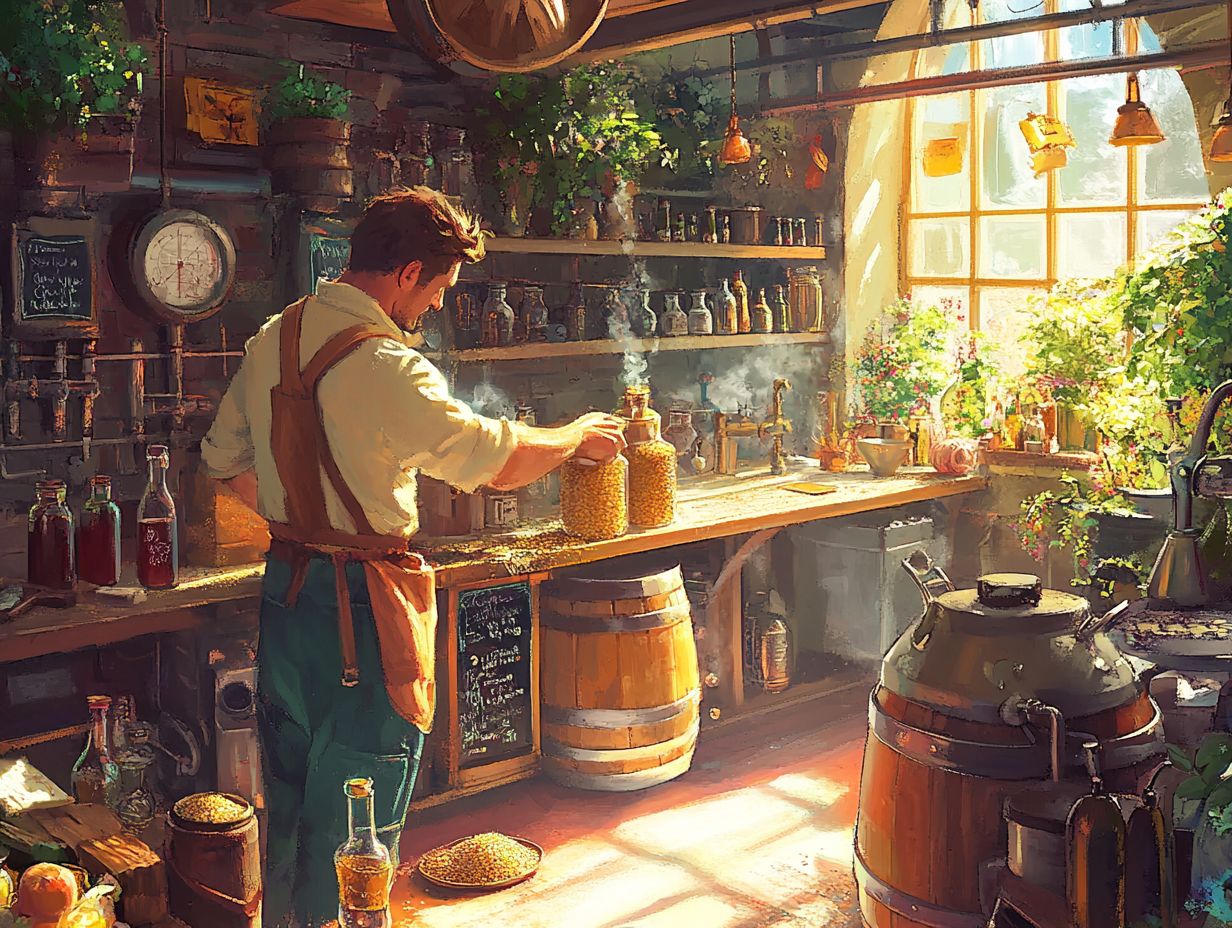
Research and education are essential for brewers. They help you master non-traditional brewing methods.
These elements empower you to craft innovative flavors that truly resonate with your consumers.
By exploring various resources, such as specialized workshops that provide hands-on experience with unique ingredients and processes, or online courses offering flexible learning options for both budding and established brewers, you can elevate your craft to new heights.
Engaging in industry conferences keeps you updated on the latest trends and technologies. It also nurtures a sense of community through networking with fellow enthusiasts.
Staying informed about these developments and looking into successful case studies from your peers is vital for incorporating fresh ideas and enhancing your overall brewing practice.
2. Start Small and Experiment
Starting small fuels your creativity and invites exciting, bold flavors. Experimenting with various brewing techniques allows you to explore new ideas without the risks that come with larger production runs.
For example, imagine crafting a unique hibiscus-infused ale in a small batch. You d gain invaluable feedback from your loyal patrons, and that limited release could unexpectedly gain popularity, eventually becoming a staple on your menu.
Experimenting with barrel aging in smaller quantities can also reveal complex flavor profiles. Consider a craft brewery that perfected a rich coffee stout through careful adjustments of their small-scale methods.
By embracing small batch production, you can cultivate a vibrant array of offerings that truly resonate with your community.
3. Use Quality Ingredients
Using quality ingredients is essential to the brewing process. They directly impact the final flavor profiles and overall quality of your beer.
When you prioritize high-quality components, you unlock the potential for unique flavors and aromas that elevate your brew. This becomes particularly important when experimenting with alternative grains like quinoa, millet, or buckwheat, which offer distinctive notes while accommodating various dietary restrictions.
Addressing potential allergen concerns is crucial in today s diverse market. Sourcing gluten-free options significantly broadens your audience reach.
Ensuring that all ingredients are meticulously evaluated for freshness and purity enhances your brewing experience and creates a product that resonates with health-conscious consumers, leading to a more successful brew.
Challenges and Considerations for Non-Traditional Brewing
While non-traditional brewing techniques open up a world of innovative possibilities, they also introduce distinct challenges. You must navigate these to guarantee the safety and quality of your products.
1. Equipment and Space Limitations
Equipment and space limitations can present considerable challenges for craft breweries as they strive to implement non-traditional brewing techniques effectively. These constraints narrow your options for brewing methods and influence your fermentation management practices.
For example, small fermenters may restrict batch sizes, impacting the consistency and scalability of your unique beers.
You can optimize your processes by exploring techniques like sequential fermentation, which offers flexibility in utilizing the equipment at hand.
Investing in modular equipment or innovative container designs can enhance your space efficiency and improve your brewing outcomes.
By leveraging technology and refining your workflow, you can tap into your creativity and produce distinctive flavors, even when resources are limited.
2. Consistency and Reproducibility
Achieving consistency and reproducibility in your brewing processes can be particularly challenging, especially when you venture into non-traditional techniques. This requires an attentive eye on quality control.
To navigate these complexities, you should prioritize thorough documentation of every step in your process, from sourcing ingredients to the precise methods employed during production. This meticulous record-keeping give the power tos you to replicate successful batches and identify any deviations that could impact the final product s flavor.
Sourcing high-quality ingredients is absolutely essential, as variations in raw materials can significantly influence taste. By implementing rigorous quality control measures throughout your brewing process, you ensure that each batch meets your desired standards, fostering trust among consumers and enhancing the overall experience of your craft.
3. Safety and Sanitation
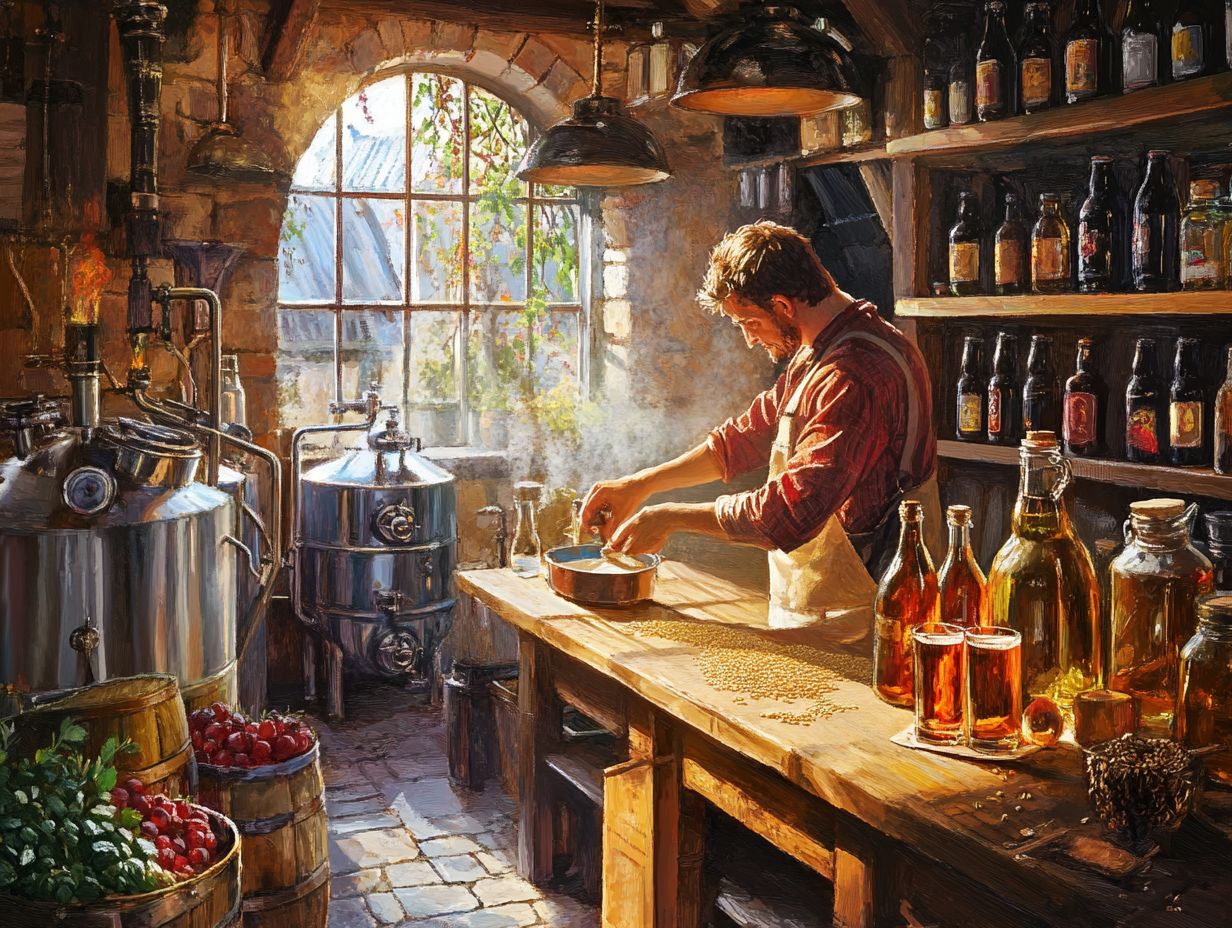
Safety and sanitation are of utmost importance in the brewing process, especially when you venture into non-traditional techniques that may introduce new risks.
To navigate these uncharted territories successfully, you must adopt stringent hygiene practices from start to finish. This means thoroughly cleaning all equipment and surfaces before use, as any lingering contaminants can compromise the final product.
Regularly monitoring fermentation conditions is equally essential, particularly when employing wild fermentation. Factors like temperature and microbial presence can significantly impact the outcome, so staying vigilant is key.
When incorporating innovative ingredients, take the time to carefully consider their source and handling to prevent spoilage or contamination. By establishing clear safety protocols, conducting routine checks, and fostering a clean environment, you can fully embrace the creative brewing process while minimizing potential hazards.
Frequently Asked Questions
What are non-traditional brewing techniques?
Non-traditional brewing techniques refer to methods of making beer that differ from traditional methods, such as using unconventional ingredients or fermentation processes.
Why would someone want to explore non-traditional brewing techniques?
Exploring non-traditional brewing techniques can lead to unique and innovative flavors in beer, and can also be a way to experiment and push the boundaries of traditional brewing.
Are there any risks associated with non-traditional brewing techniques?
Like any brewing process, there are always some risks involved. It is important to thoroughly research and understand the techniques before attempting them to ensure safety and quality of the final product.
What are some examples of non-traditional brewing techniques?
Some examples of non-traditional brewing techniques include barrel aging, souring, and using alternative grains and fruits in the brewing process.
Do non-traditional brewing techniques require special equipment?
Some non-traditional techniques may require specialized equipment, such as a barrel for barrel aging or a specific type of yeast for souring. However, many techniques can be done with basic brewing equipment.
Can homebrewers explore non-traditional brewing techniques?
Absolutely! Homebrewers have the freedom to experiment and try new techniques without the pressure of producing large quantities for commercial sale. Just be sure to research and understand the process thoroughly before attempting it.

